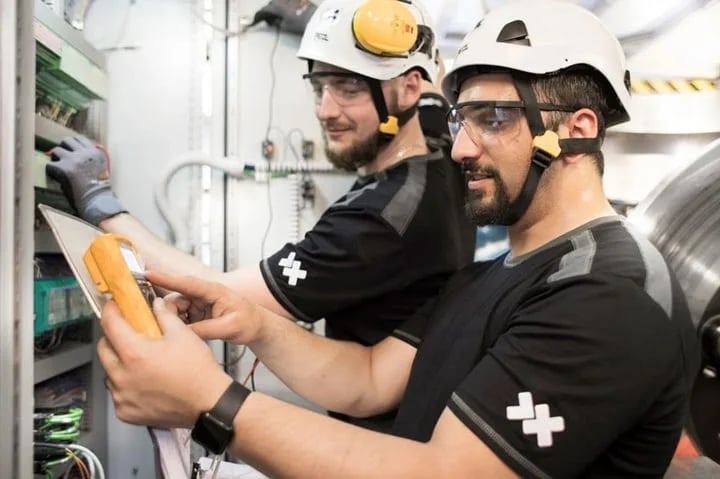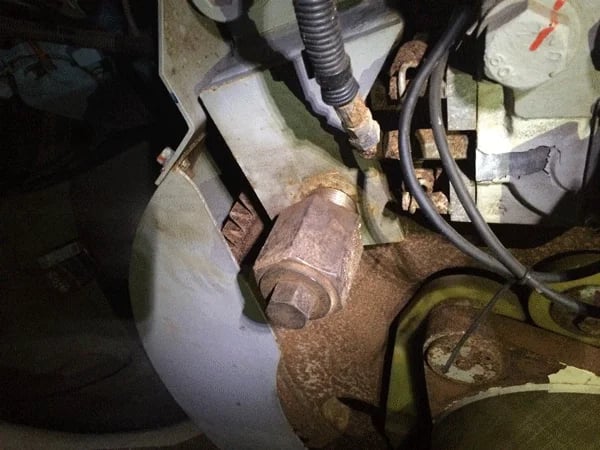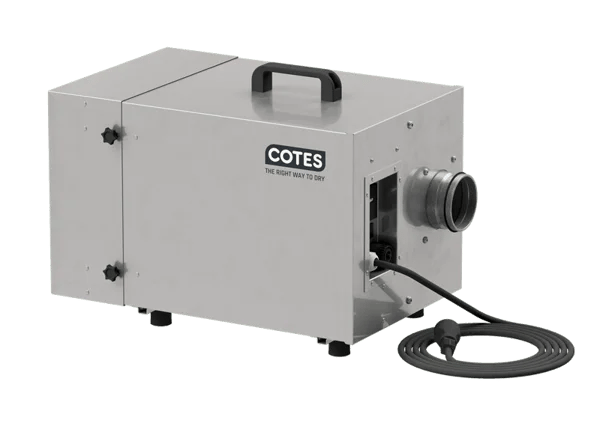Deutsche Windtechnik is a specialist in the technical maintenance of wind turbines and ensures reliable turbine operation around the clock for onshore and offshore wind farm clients all over the world.
The challenge of long drying times in wind turbines
One of the challenges facing the wind industry is long drying (out) times. Drying times have a detrimental effect on the maintenance, operability and servicing costs for wind turbines that have been off-grid for more than 48hrs. With a Cotes dehumidifier, Deutsche Windtechnik will reduce drying times, ease maintenance and increase operational efficiency.
When certain turbines and software types have been out of use for more than two days these electrical components need to be preheated in order to operate the turbine again. This lengthy process can become an operational deficit. The process entails heating up cooling water and cycling it through a power converter, during which water and moisture are removed from within the electrical machines.
This heating period is essential for avoiding damage to the sensitive equipment but requires about 24hrs of continuous drying efforts that warrant a standstill of the turbine processes. Avoiding humidity in wind turbines is a crucial task that could prevent your assets from experiencing electrical failures.
According to an independent study conducted by Fraunhofer, there is a direct link between humidity levels and occurrences of electrical failures in wind turbines, making the drying out time a necessary evil to reduce damage to vital equipment (Fischer et al. (2021)). Cotes engineers are more than familiar with the dangers of this uncontrolled humidity and strive to find solutions for the maintenance of electrical components in humid environments. Uncontrolled humidity may, for example, very well be the main cause of generator failures you have experienced in the past.
These risk factors aren't news to Deutsche Windtechnik either, who have seen many industry stakeholders struggling to prevent corrosion on steel or moisture in their electronics. That is why this project is concerned with tackling the deficiency of long drying out times through the right preventative dry-air strategy to help on- and offshore turbines regulate their humidity levels and protect their assets. The type of issues you want to avoid and protect against is for example defective delta modules that have to be replaced due to short circuits caused by high humidity and condensation, which leads to creep voltage.
The right way to dry your wind turbine

Image: Deutsche Windtechnik
In Texas, extreme weather conditions led to the freezing of turbines that lead to long drying times as turbines were taking a long time to defrost. This had significant implications for the maintenance costs, operational costs, and safety risks of wind farms in the region. Below is an image from a wind turbine close to Corpus Christi, Texas USA, where there was no dry-air strategy or adsorption dehumidifier.
 Image: This is the inside of a wind turbine nacelle, located close to Corpus Christi, Texas USA, where high humidity levels cause corrosion.
Image: This is the inside of a wind turbine nacelle, located close to Corpus Christi, Texas USA, where high humidity levels cause corrosion.
|
Mogens Sode Nielsen, Technical Sales Manager for Cotes Wind explains: “We know from our experience in onshore wind farms, in typically colder regions, that when all that snow and ice melts, asset owners will, unfortunately, face even more humidity issues in their turbines and expose critical systems to electrical failure and corrosion. The humidity can cause converters, transformers and control systems to fail. Having a dry-air strategy is a must, whether your wind turbine is onshore, offshore or nearshore.”
|
|
Similarly so, Deutsche Windtechnik realised the significance of this issue as the company is responsible for multiple wind farms in different locations that have been exposed to extreme weather conditions:
"Using a Cotes dehumidifier not only increases the availability of these wind turbines with a faster startup process, but also reduces the failure rate of expensive components. We chose Cotes because they have a proven trackrecord in the wind industry and the results simply speak for itself." Martin Swart, Senior Manager Engineering at Deutsche WiIndtechnik.
Determining the right way to dry your wind turbine depends on your dry-air needs and strategy. Finding the right dry-air solution requires that you carefully examine all the real-life factors that affect and shape the environment of your wind farms:
- Regional and local weather conditions
- Temperature fluctuations
- Relative Humidity in the air
- The salinity of the air
- Risk of Corrosion (Check out our global Corrosion index map and our guide on how to use it)
- Increased vulnerability to extreme weather events
The benefits of dry air
Not being able to dry the wind turbine quickly and effectively costs a lot of money in downtime and is considered a major shortcoming in running an efficient wind farm for many of Deutsche Windtechnik´s clients. In partnering up with Cotes to target this issue and develop a preventative strategy to reduce those costs and increase uptime and productivity, Deutsche Windtechnik also realised that there are many more stakeholders, turbine types, and issues that could be helped by improving the wind farms’ access to dry air.
The tests that Deutsche Windtechnik are running with Cotes stand to offer industry stakeholders a variety of innovative, preventative, and proactive solutions for the future of both off- and onshore wind farm operability while supplying them with all the other benefits of dry air:
- Avoiding mould and corrosion
- Avoiding electrical faults in your turbines
- Safeguarding durability and performance of sensitive equipment
- Creating a safer working environment
- Faster, glitch-free turbine commissioning
- Lower costs for materials, coating and components
Stiesdal COO, Peder Nickelsen, also commented on the wholesome value of dry air for the operation and maintenance of assets in the global wind industry in an exclusive interview with Cotes. The right dry air strategy can provide a wind farm with far more than just shorter drying out times.
Follow the Deutsche Windtechnik and Cotes project

Image: The CR80 Cotes Dehumidifier is mobile and easy to install
Deutsche Windtechnik began the testing of the Cotes dehumidification units in a wind turbine of a German onshore wind farm in January of 2021. A Cotes standard CR80 model was installed to investigate its effects on the turbines’ drying times and benefits for the safety of the electrical components. To best compare the results from before and after the installation, sensors were applied inside the power converter of the German turbine to measure humidity levels in various places, as it is intended for any tests to be run in the future.
Deutsche Windtechnik has already reported early findings from the site in Germany that make us optimistic for the future of this research. We expect to have concrete results from the farm by the end of the year with significant outcomes for various stakeholders and owners in the wind industry.
Until then Cotes is and will continue to be in close contact with wind turbine owners across the globe to learn more about the various issues they face and to collect ideas for solution approaches that could inform and inspire some of Deutsche Windtechnik’s and Cotes’ upcoming projects.
Speak to a Cotes expert or ask for a test
If you think you could benefit from reduced drying out times in your wind turbines and would like to participate in similar testing of Cotes dry-air solutions, please contact our Wind Sales Specialist Mogens on LinkedIn or write him at msn@cotes.com. We strive to find the right dry-air solution for your business regardless of your location, turbine type, or humidity concern!
.webp?width=511&height=511&name=Wind_Lineup_01%20(2).webp) READ MORE:
READ MORE:- Avoiding electrical failures and corrosion
- Likelihood of mould in individual offshore wind turbines
- Floating offshore wind turbine structures.
.webp?width=235&height=157&name=Mogens%20(2).webp)
